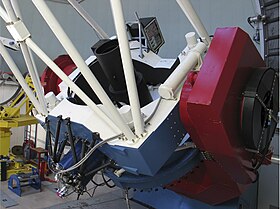
The Gamma-Ray Burst Optical/Near-Infrared Detector (GROND) is an imaging instrument used to investigate Gamma-Ray Burst afterglows and for doing follow-up observations on exoplanets using transit photometry. It is operated at the 2.2-metre MPG/ESO telescope at ESO's La Silla Observatory in the southern part of the Atacama desert, about 600 kilometres north of Santiago de Chile and at an altitude of 2,400 metres.
Discoveries
- On 13 September 2008, Swift detected gamma-ray burst 080913. GROND and VLT subsequently placed the GRB at 12.8 Gly distant, making it the most-distant GRB observed, as well as the second-most-distant object to be spectroscopically confirmed.
- On 15 September 2008, NASA's Fermi Gamma-ray Space Telescope detected gamma-ray burst 080916C. On 19 February 2009, NASA announced that the GROND team's work shows that the GRB was the most energetic yet observed, and 12.2 Gly distant.
See also
- Red shift observations in astronomy
- Photometry (astronomy)
- Max Planck Institute for Extraterrestrial Physics
References
- Snellen, I. A. G.; Koppenhoefer, J. (2008). "OGLE2-TR-L9b: an exoplanet transiting a rapidly rotating F3 star" (PDF). Astronomy & Astrophysics. 497 (2): 545–550. arXiv:0812.0599. Bibcode:2009A&A...497..545S. doi:10.1051/0004-6361/200810917. S2CID 15639369.
- Nikolov, N.; Henning, Th.; Koppenhoefer, J.; Lendl, M.; MacIejewski, G.; Greiner, J. (2012). "WASP-4b transit observations with GROND". Astronomy & Astrophysics. 539: A159. arXiv:1201.5727. Bibcode:2012A&A...539A.159N. doi:10.1051/0004-6361/201118336. S2CID 59017585.
- "GROND Takes Off" (Press release). European Organisation for Astronomical Research in the Southern Hemisphere (ESO). 2007-07-06. Archived from the original on 2009-02-25. Retrieved 2009-02-23.
- "NASA's Swift Catches Farthest Ever Gamma-Ray Burst" (Press release). NASA. 2008-09-19. Retrieved 2009-02-23.
- Greiner, Jochen; et al. (2009). "GRB 080913 at redshift 6.7". The Astrophysical Journal. 693 (2): 1610–1620. arXiv:0810.2314. Bibcode:2009ApJ...693.1610G. doi:10.1088/0004-637X/693/2/1610. S2CID 14713585.
- "NASA's Fermi Telescope Sees Most Extreme Gamma-ray Blast Yet" (Press release). NASA. 2009-02-19. Retrieved 2009-02-23.
- Greiner, Jochen; et al. (2009-02-04). "The redshift and afterglow of the extremely energetic gamma-ray burst GRB 080916C". Astronomy and Astrophysics. 498 (1): 89–94. arXiv:0902.0761. Bibcode:2009A&A...498...89G. doi:10.1051/0004-6361/200811571. S2CID 6758498.
External links
This article about a specific observatory, telescope or astronomical instrument is a stub. You can help Misplaced Pages by expanding it. |